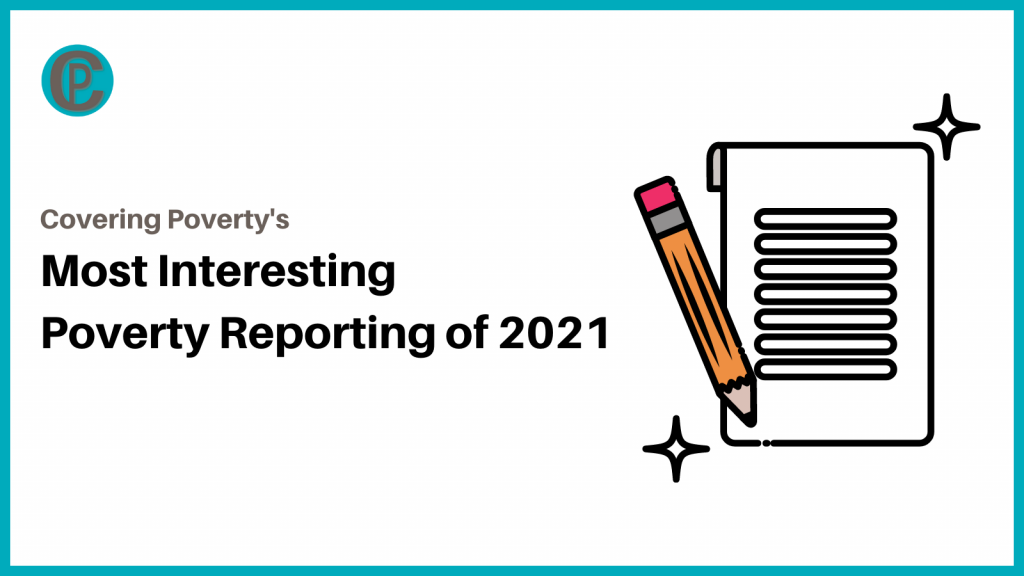
Covering Poverty has compiled some of the most interesting reporting from 2021, from video stories, to features, to photography. Read why we chose them below.
The Geography of Food Insecurity in America
The GroundTruth Project
This story was produced as part of “Barren Mile: COVID-19 and the fight against food apartheid,” which was a Report for America initiative that brought together four Black-owned newsrooms — New York Amsterdam News, the Atlanta Voice, St. Louis American and Black Voice News — to look at how COVID-19 impacted food security in their communities. This specific piece features photographs from various towns in America to document what food insecurity looks like from Sitka, Alaska to Athens, Georgia.
These Single Mom Are Forced to Choose: Reveal Their Sexual Histories or Forfeit Welfare
ProPublica
This ProPublica piece examines welfare funding’s frequent requirement that women identify who fathered their children and when they became pregnant, among other deeply personal details. This practice has deep roots in U.S. history — back to the bastardy laws of colonial times. The contemporary, less violent arrangement requires states to “go after fathers of children whose mothers had applied for welfare, in an attempt to get them to pay child support to the government as repayment for those welfare dollars.” This piece makes our list because of its deep examination of the welfare legislation and its focus on the affected mothers.
When Dasani Left Home
The New York Times
In 2013, the story of Dasani Coates took up five pages in The New York Times. With eight siblings, Dasani and her family lived in a city-run homeless shelter in Brooklyn. This original piece provided a rare look into how homelessness affects the course of one’s life.
In September 2021, The New York Times Magazine published another piece — When Dasani Left Home. New York Times writer Andrea Elliot was allowed to follow Dasani’s family for almost 10 years, and in the follow-up piece, Dasani separates from her family at 13 years old to attend Milton Hershey school – a boarding school that tries to rescue children from poverty. This makes our list because of the author’s dedication to telling this story, and the attention to carefully tell Dasani’s story. (The author has also published a book: “Invisible Child: Poverty, Survival & Hope in an American City”).
“It’s a walkout!” Inside the fast-food workers’ season of rebellion
The Washington Post
This piece tells the story of an employee walk-out in Bradford, Pennsylvania, a town with a 30 percent poverty rate. McDonalds’ employees from a Bradford location, tired of low wages, 60-hour workweeks and an emotionally taxing job, banded together and walked out of the McDonald’s in protest. This story examines the aftermath of the walkout and provides context on the working conditions and low wages of the corporate fast-food industry.
Pandemic Prompts More Black Americans to Take Up Urban Gardening to End “Food Apartheid”
St. Louis American/Mother Jones
This story was produced as part of “Barren Mile: COVID-19 and the fight against food apartheid,” which was a Report for America initiative that brought together four Black-owned newsrooms — New York Amsterdam News, the Atlanta Voice, St. Louis American and Black Voice News — to look at how COVID-19 impacted food security in their communities. This particular piece looks at how Black people, who were affected by food insecurity at higher levels than white people during the pandemic, took to urban gardening as “home-grown solutions to the redlining-induced problem of limited access to healthy foods.” This piece also addresses how “food deserts,” or what activists call sites of “food apartheid,” systemically affected Black communities.
How America’s hottest city is trying to cool down
Vox
This video examines how Pheonix’ urban design contributes to extreme heat in the city. The city is looking to trees as part of its heat mitigation strategy, but trees are distributed unevenly across the city. There are fewer trees in the south and west, which is where many lower-income neighborhoods are located. This piece does an incredible job at explaining how trees could be a solution, and at exploring the promises – and gaps – of the city’s “tree equity” plan.
“Biblical” flooding in South Sudan displaces hundreds of thousands.
CNN
This reporting from CNN’s International Correspondent Clarissa Ward details how extreme flooding in south Sudan displaced hundreds of thousands, pushing many into poverty. This illustrates how climate change will affect everyone, and those in poverty are the most vulnerable.
Hidden Nashville
Bitter Southerner
This story follows nonprofit outreach and resource navigator Susan Adock as she builds relationship with Nashville’s homeless population. Adock also is a photographer, and uses her photography to advocate for those affected by poverty. This deeply personal piece follows Susan’s work and also details how Nashville’s homeless have become increasingly vulnerable, from a tornado and bombing in 2020 to the city’s clearing of homeless camps.
A Long-Deferred Hope for Better Housing
The Washington Post Magazine
This piece examines housing support in the economically depressed Missisippi Delta, a majority-Black rural region in the South. It tells the story of one woman’s home renovation after her house had decayed throughout her years of occupancy, and the piece also shines a light on housing injustice in the region. Photos document how the home renovation — made possible from a state grant — improved the woman’s home.
Disruptions to schooling fall hardest on vulnerable students
The Associated Press
This story describes why vulnerable students, often living in poverty, were the hardest hit from school disruptions amid the coronavirus pandemic. Families often don’t have the resources to deal with breakdowns in the public education system, and can’t educate their child when they are exposed to COVID-19 and have no access to online schooling.
Kyra Posey is a graduate student studying journalism at the University of Georgia.

